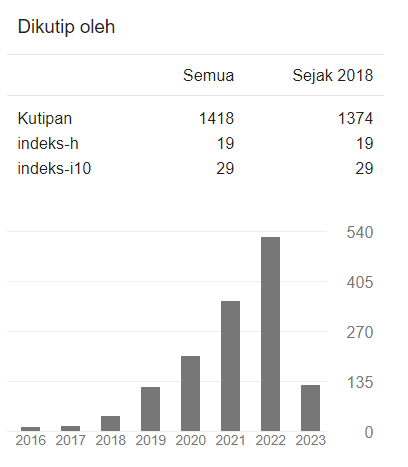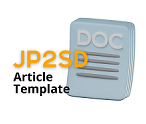Analysis Of Students’ Errors in Solving AKM Problems Perimeter and Area of Flat Shape
DOI:
https://doi.org/10.22219/jp2sd.v12i2.33784Keywords:
error analysis, about AKM, polya step, perimeter and area of flat shapeAbstract
Numeration in AKM, which is contextualized in various types of questions, aims to evaluate student competence. So, it is necessary to know where students' mistakes are to improve how students solve mathematical problems. This research aims to describe students' mistakes in solving problems on AKM questions related to the perimeter and area of flat shapes. This research is descriptive qualitative research. The research subjects chosen in this study were based on consideration of students' mathematical ability test results in the high (80 to 90), medium (65 to 80), and low (less than 65) categories. Then, three students were randomly selected for each ability level, with details: 1 student with high ability, 1 with medium ability, and 1 with low ability. The data collection techniques used in this research aretests, interviews, and documentation. Data analysis techniques used in the Miles and Huberman model can help understand problems well and plan problem-solving systematically. Students who are in the low category are not yet able to fulfill every indicator of solving mathematical problems and are not able to solve the problems given correctly.
Downloads
References
Az-Zahroh, S. F., & Permadi, H. (2022). Analisis Kesalahan Mahasiswa dalam Menyelesaikan Soal Literasi Numerasi pada Materi Sebaran Geometrik dan Binomial Negatif. GAUSS: Jurnal Pendidikan Matematika, 5(2), 40–52. https://doi.org/10.30656/gauss.v5i2.5712
Azhar, E., Saputra, Y., & Nuriadin, I. (2021). Eksplorasi Kemampuan Pemecahan Masalah Matematis Siswa Pada Materi Perbandingan Berdasarkan Kemampuan Matematika. AKSIOMA: Jurnal Program Studi Pendidikan Matematika, 10(4), 2129. https://doi.org/10.24127/ajpm.v10i4.3767
Famela, N., Sulistyowati, F., Kusumaningrum, B., & Deshinta, A. (2023). Analisis Kesalahan Siswa dalam Menyelesaikan Asesmen Kompetensi Minimum ( AKM ) berdasarkan Langkah Penyelesaian Polya. (November), 636–648.
Indahri, Y. (2021). Asesmen Nasional sebagai Pilihan Evaluasi Sistem Pendidikan Nasional. Aspirasi: Jurnal Masalah-Masalah Sosial, 12(2), 195–215. https://doi.org/10.46807/aspirasi.v12i2.2364
Kahar, M. I., Cikka, H., Afni, N., & Wahyuningsih, N. E. (2021). Pendidikan Era Revolusi Industri 4.0 Menuju Era Society 5.0 di Masa Pndemi COVID 19. Jurnal Studi Ilmu Pengetahuan Sosial (Moderasi), 2(1), 58–78. https://doi.org/https://doi.org/10.24239/moderasi.Vol2.Iss1.40
KEMENDIKBUD RISTEK. (2023). Apa itu Literasi dan Numerasi? Retrieved from 2023 website: https://ditpsd.kemdikbud.go.id/artikel/detail/apa-itu-literasi-dan-numerasi#:~:text=Literasi numerasi adalah kecakapan untuk,literasi numerasi kepada anak-anak%3F
Kuncoro, K. S., Zakkia, A., Sulistyowati, F., & Kusumaningrum, B. (2021). Students’ Mathematical Critical Thinking Based on Self-Esteem Through Problem Based Learning in Geometry. Southeast Asian Mathematics Education Journal, 11(1), 41–52. https://doi.org/10.46517/seamej.v11i1.122
Kurniadi, E., Gusriani, N., Subartini, B., & Napitupulu, H. (2020). Penguatan Konsep Matematika Melalui Alat Peraga Matematika Permainan di SDN Cikuda Jatinangor. BERNAS: Jurnal Pengabdian Kepada Masyarakat, 1(4 SE-Articles), 561–568. https://doi.org/10.31949/jb.v1i4.535
Mendikbud. Surat Edaran Nomor 4 Tahun 2020 Pelaksaan Kebijakan Pendidikan Dalam Masa Darurat Penyebaran Coronavirus Disease (COVID-19). , Pub. L. No. 4 (2020). Indonesia.
Mulyadi, N. A., & Manoy, J. T. (2022). Representasi Siswa dengan Kemampuan Matematis Tinggi dalam Memecahkan Masalah Matematika. Jurnal Cendekia : Jurnal Pendidikan Matematika, 6(1), 533–546. https://doi.org/10.31004/cendekia.v6i1.1281
Napsiyah, N., Nurmaningsih, N., & Haryadi, R. (2022). Analisis Kemampuan Numerasi Matematis Siswa Berdasarkan Level Kognitif pada Materi Kubus dan Balok. JagoMIPA: Jurnal Pendidikan Matematika Dan IPA, 2(2), 103–117. https://doi.org/10.53299/jagomipa.v2i2.183
Nurfadhillah, S., Ramadhanty Wahidah, A., Rahmah, G., Ramdhan, F., & Claudia Maharani, S. (2021). Penggunaan Media Dalam Pembelajaran Matematika Dan Manfaatnya Di Sekolah Dasar Swasta Plus Ar-Rahmaniyah. EDISI : Jurnal Edukasi Dan Sains, 3(2), 289–298. Retrieved from https://ejournal.stitpn.ac.id/index.php/edisi
Nurjanah, E. (2021). Kesiapan Calon Guru SD dalam Implementasi Asesmen Nasional. Jurnal Papeda: Jurnal Publikasi Pendidikan Dasar, 3(2), 76–85. https://doi.org/10.36232/jurnalpendidikandasar.v3i2.1120
Peraturan Pemerintah Nomor 19 Tahun 2005 Tentang Standar Nasional Pendidikan. , Pub. L. No. 19 (2005).
Poernomo, E., Kurniawati, L., & Atiqoh, K. S. N. (2021). Studi Literasi Matematis. ALGORITMA: Journal of Mathematics Education, 3(1), 83–100. https://doi.org/10.15408/ajme.v3i1.20479
Polya, G. (1973). How To Solve it : A New Aspect of Mathematical Method. USA: Pricenton University Press.
PUSMENDIK. (2022). Komponen, Level, Domain, Subdomain, Kompetensi dan Contoh Soal. Retrieved June 22, 2024, from https://pusmendik.kemdikbud.go.id/an/asesmen_kompetensi_minimum/view/literasi-matematika
Ratnasari, J. R., & Setiawan, Y. E. (2022). Literasi Numerasi Siswa Dalam Pemecahan Masalah Segiempat Dan Trapesium. AKSIOMA: Jurnal Program Studi Pendidikan Matematika, 11(3), 2533. https://doi.org/10.24127/ajpm.v11i3.5714
Rizqiani, S. A., & Hayuhantika, D. (2020). Analisis metakognisi dalam penyelesaian masalah matematika ditinjau dari tingkat kemampuan matematika. JP2M (Jurnal Pendidikan Dan Pembelajaran Matematika), 5(1), 26. https://doi.org/10.29100/jp2m.v5i1.1734
Rohim, D. C. (2021). Konsep Asesmen Kompetensi Minimum untuk Meningkatkan Kemampuan Literasi Numerasi Siswa Sekolah Dasar. Jurnal VARIDIKA, 33(1), 54–62. https://doi.org/10.23917/varidika.v33i1.14993
Silalahi, N., & Deri Hendriawan. (2022). Analisis Kemampuan Numerik Siswa Kelas V dalam Mengerjakan Soal Tipe HOTS. Jurnal Lensa Pendas, 7(2), 113–122. https://doi.org/10.33222/jlp.v7i2.1835
Sugiyono. (2022). Metode Penelitian Kuantitatif Kualitatif dan R&D. Bandung: Alfabeta.
Susanti, Y. (2020). Pembelajaran Matematika dengan Menggunakan Media Berhitung di Sekolah Dasar dalam Meningkatkan Pemahaman Siswa. EDISI : Jurnal Edukasi Dan Sains, 2(3), 435–448. Retrieved from https://ejournal.stitpn.ac.id/index.php/edisi
Wardhani, I. (2020). Penelitian Tindakan Kelas. Jakarta: Universitas Terbuka.
Widarti, P. (2016). Desain Induk Gerakan Literasi Sekolah. Jakarta: Dirjen Dikdasmen Kementerian Pendidikan dan Kebudayaan.
Wijaya, A., & Dewayani, S. (2021). Framework asesmen kompetensi minimum (AKM). Jakarta: Pusat Asesmen dan Pembelajaran Badan Penelitian dan Pengembangan dan Perbukuan Kementerian Pendidikan dan Kebudayaan.
Yuliani, E. N. (2018). Kemampuan Pemahaman Konsep Matematis Siswa VIII SMPN 1 Kuok Melalui Model Pembelajaran Kooperatif Tipe Group Invstigation. Jurnal Cendekia: Jurnal Pendidikan Matematika, 2(2), 91–100.
Downloads
Published
Issue
Section
License
Copyright (c) 2024 Yeni Tri Wahyuni, Intan Sari Rufiana, Siti Faizah, Shirly Rizki Kusumaningrum, Radeni Sukma Indra Dewi

This work is licensed under a Creative Commons Attribution-ShareAlike 4.0 International License.
Authors who publish with Jurnal Pemikiran dan Pengembangan Sekolah Dasar (JP2SD) agree to the following terms:
- For all articles published in Jurnal Pemikiran dan Pengembangan Sekolah Dasar (JP2SD), copyright is retained by the authors. Authors give permission to the publisher to announce the work with conditions. When the manuscript is accepted for publication, the authors agree to automatic transfer of the publishing right to the publisher.
- Authors retain copyright and grant the journal right of first publication with the work simultaneously licensed under a Creative Commons Attribution-ShareAlike 4.0 International License that allows others to share the work with an acknowledgment of the work's authorship and initial publication in this journal.
- Authors are able to enter into separate, additional contractual arrangements for the non-exclusive distribution of the journal's published version of the work (e.g., post it to an institutional repository or publish it in a book), with an acknowledgment of its initial publication in this journal.
- Authors are permitted and encouraged to post their work online (e.g., in institutional repositories or on their website) prior to and during the submission process, as it can lead to productive exchanges, as well as earlier and greater citation of published work (See The Effect of Open Access).

This work is licensed under a Creative Commons Attribution-ShareAlike 4.0 International License.


















